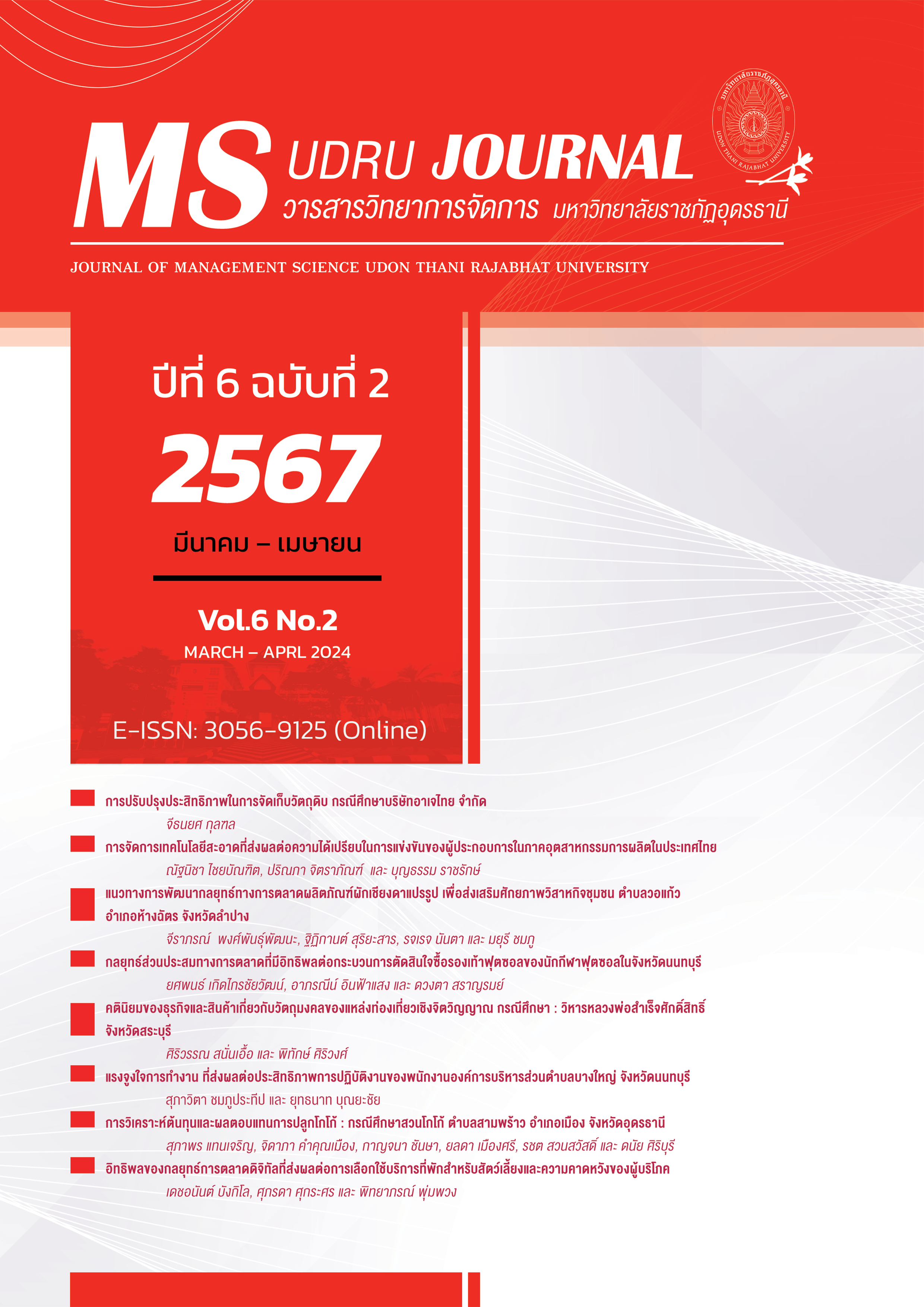THE IDEOLOGY OF BUSINESS AND PRODUCTS RELATED TO SACRED OBJECT OF SPIRITUAL TOURISM: A CASE STUDY OF VIHARN LUANG POR SAMRED SAKSIT SARABURI PROVINCE
Main Article Content
Abstract
This research was a qualitative research using a case study method. The objectives were (1) to study the concepts that lead to businesses and products related to sacred objects of spiritual tourist attractions, (2) to study the market management of business and sacred objects of spiritual tourism, a case study of Viharn Luang Por Samred Saksit Saraburi province selected a group of 8 specific key informants by collecting data by document study, in-depth interviews, observations and notes. The results of the research revealed that (1) the ideologies that resulted in businesses and products related to sacred objects of spiritual tourist attractions were divided into 2 types: It was a belief and faith gained from one's own direct experience resulting in doing business and merchandise related to sacred objects and (1.2) belief and faith Luang Por Samred Saksit indirectly, it is the belief and faith gained from the experience of others. (2) the market management of business and sacred objects of spiritual tourism at Viharn Luang Por Samred Saksit considering the marketing mix, it can be divided into 4 aspects: (2.1) The product aspect is the construction, design and name, incantation, type of product and object (2.2) The price aspect was the age liking and popularity, auspicious number, reasonable price (2.3) Distribution: storefront and online sales; and (2.4) Marketing promotion is television media, internet media, advertisement from a monk magazine and public relations from people, for factors that make customers to buy sacred objects is numerology, auspicious name, place of creation, rituals and beauty of Buddhist art.
Article Details

This work is licensed under a Creative Commons Attribution-NonCommercial-NoDerivatives 4.0 International License.
บทความที่ได้รับการตีพิมพ์เป็นลิขสิทธิ์ของคณะวิทยาการจัดการ มหาวิทยาลัยราชภัฏอุดรธานี
ข้อความที่ปรากฏในบทความแต่ละเรื่องในวารสารวิชาการเล่มนี้ ไม่ใช่ความคิดเห็นและความรับผิดชอบของผู้จัดทำ บรรณาธิการ กองบรรณาธิการ และคณะวิทยาการจัดการ มหาวิทยาลัยราชภัฏอุดรธานี ความรับผิดชอบด้านเนื้อหาและการตรวจร่างบทความแต่ละเรื่องเป็นความคิดเห็นของผู้เขียนบทความแต่ละท่าน
References
กมลชนก จันทร์แดง. (2562). ความเชื่อ Beliefs. สืบค้นเมื่อ 12 มกราคม 2566, จาก https://bcnlp56.weebly.com/index.html.
กระทรวงการท่องเที่ยวและกีฬา. (2559). รายงานภาวะเศรษฐกิจท่องเที่ยว ฉบับที่ 4 (เม.ย.-มิ.ย. 2559) Spiritual Tourism. สืบค้นเมื่อ 20 ธันวาคม 2565, จาก https://secretary.mots.go.th/ewtadmin/ewt/policy/download/article/article_20170511095605.pdf.
กิตติ ภิญโญ. (2560). ปัจจัยที่มีผลต่อความนิยมพระเครื่องของประชาชนที่มีความสนใจพระเครื่องในจังหวัดกรุงเทพมหานคร กรณีศึกษา ศูนย์พระเครื่องห้างสรรพสินค้าพันธุ์ทิพย์พลาซ่า สาขางามวงศ์วาน. การค้นคว้าอิสระปริญญานิเทศศาสตรมหาบัณฑิต มหาวิทยาลัยกรุงเทพ.
คริษฐา เกยด่านกลาง และบุษกรณ์ ลีเจ้ยวะระ. (2563). กลยุทธ์ทางการตลาดเพื่อเพิ่มยอดเช่าบูชา พระเครื่อง พระบูชาหลวงพ่อพระใสวัดอารามหลวง วัดโพธิ์ชัย จังหวัดหนองคาย. วารสารวิจัย มข., 10(1), 73-87.
ชัยภักดิ์ อรัญญภูมิ. (2560). ปัจจัยส่วนประสมทางการตลาดที่มีผลต่อการตัดสินใจเช่าพระเครื่องในตลาดทิพย์เนตร อำเภอเมือง จังหวัดเชียงใหม่. การค้นคว้าอิสระปริญญาบริหารธุรกิจมหาบัณฑิตมหาวิทยาลัยแม่โจ้.
ณัฐวุฒิ แก้ววิมล. (2558). ปัจจัยที่มีอิทธิพลต่อพฤติกรรมการตัดสินใจเช่าพระเครื่องออนไลน์ เว็บไซต์ G-pra. การค้นคว้าอิสระปริญญาเศรษฐศาสตรมหาบัณฑิต มหาวิทยาลัยธรรมศาสตร์.
พระมหามนัสวี ฐิตธมโม. (2564). การจัดการความเชื่อที่มีผลต่อจิตใจเชิงพุทธ: กรีศึกษาวัดเจดีย์ไอ้ไข่. วารสารมหาจุฬานาครทรรศน์, 8(6), 61-76.
วรธนัท อชิรธานนท์. (2563). พลังความเชื่อและความศรัทธาในวัตถุมงคลสู่เครื่องประดับและอัญมณี. วารสาร มจร เลย ปริทัศน์, 2(3), 50-61.
วิหารหลวงพ่อสำเร็จศักดิ์สิทธิ์สระบุรี. (2566). เยือนวิหารหลวงพ่อสำเร็จศักดิ์สิทธิ์ที่เที่ยวใกล้กรุงเทพ สระบุรีขอพรให้สมหวัง. สืบค้นเมื่อ 2 มกราคม 2566 จาก, https://travel.trueid.net/detail/Vx6r8lW9R3Xx.
ศิราพร ณ ถลาง. (2563). ทฤษฎีคติชนวิทยา : วิธีวิทยาในการวิเคราะห์ตำนานนิทานพื้นบ้าน. กรุงเทพฯ: จุฬาลงกรณ์มหาวิทยาลัย.
ศุภชัย เรืองสรรงามสิริ. (2552). เครื่องรางของขลังของคนไทย. กรุงเทพฯ: อมรินทร์พริ้นติ้ง แอนด์พลับลิชชิ่ง.
ศูนย์วิจัยกสิกรไทย. (2563). ตลาดพระเครื่อง. สืบค้นเมื่อ 6 กรกฎาคม 2566 จาก, https://www.kasikornresearch.com/th.
สุรชัย ปกป้อง. (2562). คนไทยกับตลาดความเชื่อ. สืบค้นเมื่อ 5 กุมภาพันธ์ 2566 จาก, https://www.kaohoon.com/column/313152.
แสง จันทร์งาม. (2534). ศาสนศาสตร์. พิมพ์ครั้งที่ 2. กรุงเทพฯ: ไทยวัฒนาพานิช.
Buzinde, CN. (2020). Theoretical linkages between well-being and tourism: The case of self-determination theory and spiritual tourism. Retrieved January 23, 2023, from https://www.sciencedirect.com/science/article/abs/pii/S0160738320300645.
Chantavanich, S. (2011). Withikan wichai choeng khunnaphap [Qualitative Research Method]. Bangkok: Chulalongkorn University Press.
Creswell, J. W. (1998). Qualitative Inquiry and Research Design: Choosing Among Five Traditions. Thousand Oaks, CA: Sage.
Haq, F., & Medhekar, A. (2019). Is Spiritual Tourism a Peace Vehicle for Social Transformation and Economic Prosperity in India and Pakistan. In Marketing Peace for Social Transformation and Global Prosperity. GIG Global, 12(1), 189-211.
Kala, D. (2021). ‘Thank you, God. You saved us’-examining tourists’ intention to visit religious destinations in the postCOVID. Current Issues in Tourism, 24(21), 1-7.
Schmitt, B. (1999). Experiential Marketing. Retrieved January 5, 2023, from http://dx.doi.org/10.1362/026725799784870496.
Sousa BB, Castro C, Luís & ME Lopes, P. (2021). Religious and Spiritual Tourism: From Its Origins to Alentejo (Portugal). Retrieved February 5, 2023, from https://www.igi-global.com/chapter/religious-and-spiritual-tourism/264826.

